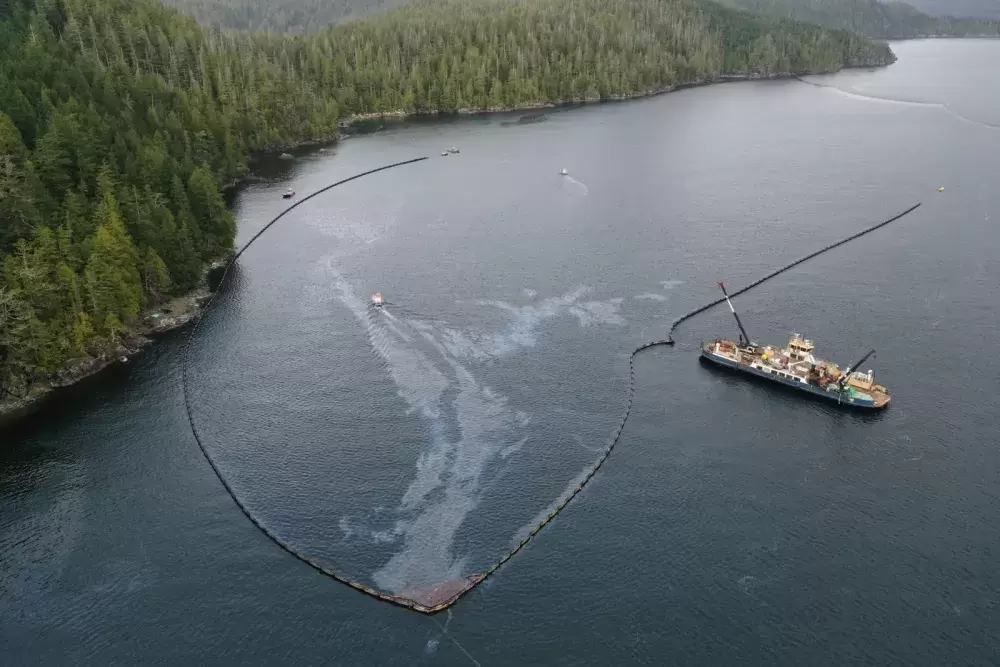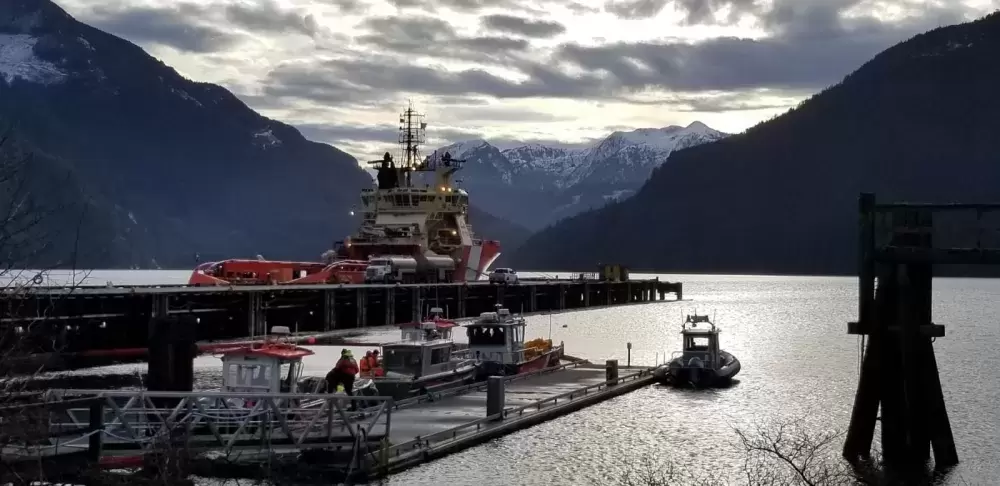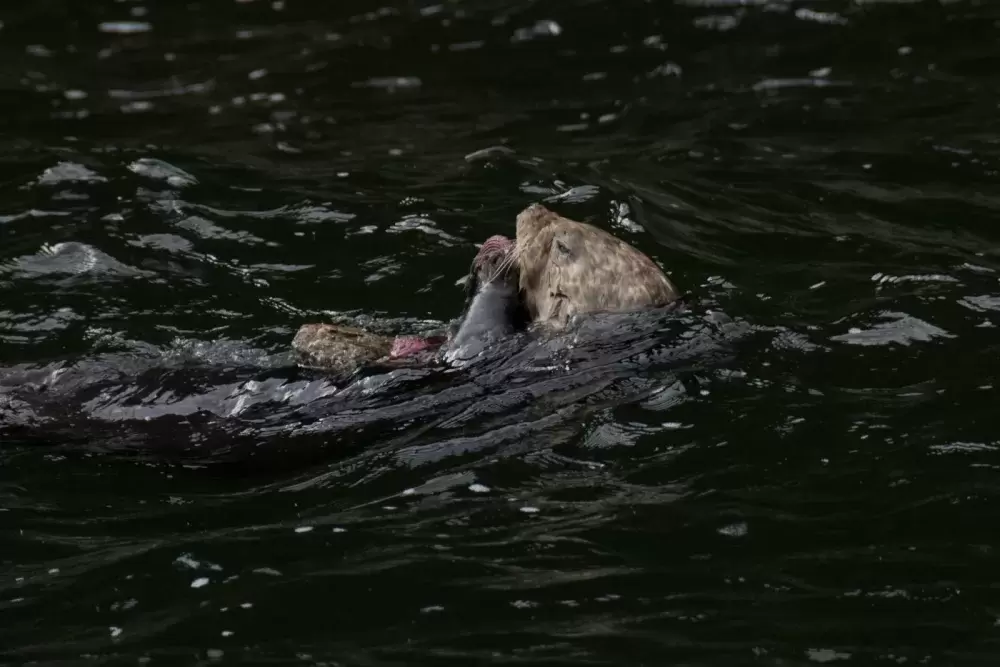Offshore booms and shoreline cleanup crews have so far managed to contain and collect heavy fuel oil seeping from a shipwreck in Nootka Sound, a unified command group says.
Jeff Brady, federal incident commander, said they have made steady progress since the operation began in early December 2020 but must still determine how to plug, patch or remove oil slowly seeping from the sunken wreck of MV Schiedyk.
“I guess the key word is stabilized,” said Brady, a Coast Guard pollution response specialist, summing up the situation six weeks into the response.
They have reached a point where the immediate threat from oil, welling to the surface at a rate of one to four litres per hour, is under control. A team of 30 on-site workers continues to focus on oil recovery in order to prevent long-term environmental damage while another 30 personnel support the effort remotely.
Difficulties encountered due to COVID, weather and communications with the site off Bligh Island have been overcome, but critical questions remain, Brady said. A remotely operated vehicle has been used to gather initial information, but authorities have not determined what will be required to resolve the situation.
“There are still a lot of challenges ahead for us,” he said. “We still don’t know how much oil is on board.”
MV Schiedyk struck a reef in January 1968 and lies hull up, 360-400 metres down, leaking one to four litres per hour. The bulk carrier had an estimated fuel capacity of 300 tons, but it was certainly not topped up after sailing from Seattle to Gold River, Brady said. The type of oil has yet to be confirmed although they assume it is Bunker C, more persistent in the environment than diesel.
Some of those answers are expected to come through technical assessment and source control contracts. Requests for proposals will be posted soon so that the contracts can be awarded in February, Brady said.
Winter weather can be rough at the best of times on the exposed coastline in Zuciarte Channel.
“We’ve had a few shutdown days and equipment breakdowns,” Brady said. “It’s a pretty nasty place and we’ve had well over 40 knots at times. The weather has had an impact on the situation.”
On one occasion, oil appeared to be drifting toward the historic village of Yuquot, raising additional concerns before the threat subsided.
Mowachaht-Muchalaht Hereditary Chief Jerry Jack, First Nations incident commander, has visited the Bligh Island wreck site a couple of times since December.
“There’s only been a few days, from what I’ve seen, where the weather has been a factor,” Jack said. In cases where the boom lines were broken, they were quickly repaired, he added. “It was stormy for a while, but as far as I can see, they’re doing the best that they can.”
Ehattesaht First Nations fisheries department, Hesquiaht First Nation and Nuu-chah-nulth Tribal Council are also part of the co-ordinated response. In-depth traditional knowledge together with technical and scientific expertise have been instrumental to the effectiveness of the response, Brady said.
Jack said the spill response has been “overwhelmingly good” from his point of view.
“It’s being contained, and I don’t think it’s gone past South Bligh Island,” he said. “Everyone is working really well together.”
Bligh Island lies in Mowachaht-Muchalaht territory east of Nootka Island at the head of Muchalat, Tlupana and Tahsis inlets. The island and surrounding archipelago are part of a provincial marine park and the area is usually frequented by boaters. A Coast Guard marine notice cautions mariners to steer clear of the emergency zone, much of which lies within the park boundary. Buoys and beacons are being installed for safety and monitoring.
To date, there seems to be little effect on wildlife in the area, said Darcy Sego, provincial incident commander with the B.C. environment ministry.
Early in the response, one oiled sea otter was observed but not captured. Another otter was found dead, but a necropsy concluded that was not related to oiling.
“There is minimal impact on wildlife in the area,” Sego said. “That’s probably due to the winter season and wildlife in the area avoiding the active operations.”
Two shoreline cleanup assessment teams are planning to survey about 100 kilometres of shoreline. Bird and mammal surveys have been done regularly. Wildlife observations by contractor Focus Wildlife have totalled thousands of birds across 30 species, though mew gulls account for more than half of the sightings. Humpback whales and orcas have been observed and identified in the vicinity.
Brady said it is tough to estimate how long the operation will have to continue. It will probably be late May by the time the technical assessment is complete.
“We’re planning for months ahead and for the operation to continue until late spring or early summer,” he said. “If the oil keeps upwelling, we have no plans to go anywhere.”
Generally, vessel owners are held responsible for cleanup costs.
“The Coast Guard is still building a file with the intention of doing cost recovery,” Brady said. “No one is stepping forward and saying, ‘I’ll pay the bills.’”
Periodic updates can be found at the unified command website, spillresponsebc.ca.









